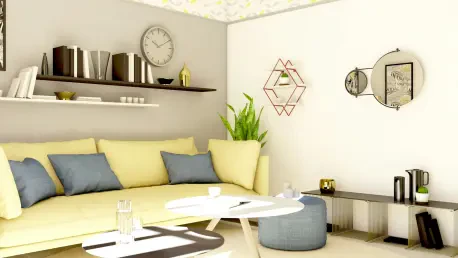In the world of interior design, costly mistakes are far from uncommon, often arising from a mix of inexperience and overzealous aspirations. Many individuals eager to reinvent their spaces fall prey to these blunders, learning lessons through financial missteps that leave lasting impressions. The allure of beautifully transformed interiors can sometimes cloud rational judgment, leading individuals down paths fraught with ill-advised choices. These experiences, while initially frustrating, are valuable learning opportunities, setting the stage for future success in home décor planning. This journey of trial and error serves as an essential part of design evolution, offering insights into navigating the complex landscape of interior design.
At the heart of many design endeavors lies a keen desire to cultivate visually appealing environments that mirror personal tastes and preferences. However, the practicalities of space utilization and physical constraints often impose limits on creativity. The dual forces of emotional impulse and pragmatic necessity shape the decision-making process, sometimes leading to results that fall short of expectations. By examining several poignant examples, this article explores common design errors that many face, aiming to bridge the gap between idealized vision and practical execution. Real-life anecdotes provide a compelling narrative, demonstrating how enthusiasm for home improvement can sometimes translate into unforeseen obstacles and tangible lessons. Through these reflections, a pathway emerges, fostering a deeper understanding of mindful and informed design choices.
Emotional Impulse vs. Practical Necessity
Designing a home is often driven by an emotional impulse that prioritizes visual appeal, but such enthusiasm can sometimes cloud the necessity for practicality. One of the most frequent missteps occurs when individuals choose materials or items for their aesthetic allure, only to discover they are challenging to maintain or impractical for everyday use. The emotional pull of a beautiful design can overshadow considerations like durability, functionality, and ease of maintenance, eventually leading to regretful expenditures and continual upkeep efforts.
A primary example can be found in the selection of certain flooring materials. While beautiful and eye-catching, flooring like terracotta tiles might seem an irresistible choice, evoking a rustic appeal that enhances a home’s character. However, such materials often demand high maintenance, absorbing spills rapidly and requiring frequent cleaning. This choice exemplifies the need for thorough research and a keen understanding of the material’s long-term requirements. By considering factors like ease of maintenance and suitability for the intended area, homeowners can avoid the annoyance of high-maintenance surfaces and focus on enjoying the aesthetic and functional benefits their investments were meant to provide.
Making such decisions requires a balance between the allure of beauty and the pragmatic demands of utility. When carefully considered, choices can both enhance the visual appeal of a home and simplify daily living. Investing time in precisely evaluating each aspect of a design choice, from how it complements existing décor to how it aligns with lifestyle needs, ensures that emotional impulses do not override practical concerns. While aesthetics are an integral component of home design, the ultimate satisfaction comes from a holistic approach that thoughtfully incorporates all aspects of daily living needs alongside visual appeal.
The Art of Measuring and Fitting
One aspect of design that frequently proves challenging is the accurate measurement and fitting of interior elements. This task, while seemingly straightforward, is fraught with potential pitfalls that can lead to costly rectifications. A striking example is the purchase of a rug that, though visually appealing, turns out to be underwhelmingly sized for its intended space. The allure of a beautifully crafted piece can tempt buyers to overlook practical details such as proper measurements, leading to a disconnect between initial intentions and actual usage.
Similarly, furniture purchases, particularly those of significant pieces like sofas or large tables, require meticulous attention to space constraints and dimensions. An L-shaped couch might seem perfect in its appeal and functionality, yet without anticipating future moves or spatial versatility, individuals may find themselves burdened with a piece that lacks adaptability. This realization emphasizes the importance of considering not just the immediate fit within a given space but also how furniture items might transition across different home layouts over time.
Thus, measurement and fitting are crucial skills in the realm of interior design, playing pivotal roles that influence the overall harmony and functionality of a space. Emphasizing the importance of thorough planning, individuals can achieve a seamless blend of both beauty and purpose in their living environments. By dedicating effort to these basic yet essential tasks, homeowners avoid common design blunders while cultivating spaces that not only reflect personal style but also serve practical living needs efficiently and effectively.
Navigating Household Dynamics
Interior design decisions must also account for the dynamics within the household, embracing considerations that extend beyond aesthetics to ensure compatibility with lifestyle elements such as children, pets, and frequent social gatherings. A common oversight is in the selection of fabrics and materials that are not suited for the lively activity within a household, leading to premature wear and continual maintenance efforts. For instance, a linen sofa, while sophisticated in appearance, may not fare well against the challenges posed by pets and young children, who may inadvertently contribute to its untimely deterioration.
In many homes, balancing style with functionality requires a thoughtful approach that embraces not just the resident’s lifestyle but also anticipates the demands of daily living. The playful antics of children or the exuberance of pets necessitate durable, easy-to-maintain furniture and décor choices. Making informed decisions about materials and design can enhance both the longevity and enjoyment of a space by minimizing upkeep and preserving the overall aesthetic appeal. It is essential to align design visions with the practical realities of daily life, ensuring the created environment remains both enjoyable and practical for all household members.
In essence, navigating household dynamics within the design process fosters spaces conducive to all inhabitants, enhancing comfort and style simultaneously. By embracing the realities of lifestyle requirements, homeowners can create interiors that cater to both personal and shared experiences within the home. Robust materials, strategic planning, and foresight ensure that a space not only reflects an individual’s taste but also accommodates the lively rhythm of everyday life without sacrificing elegance or visual appeal.
Balancing Aesthetics and Functionality
In the intricate dance of interior design, achieving a harmonious balance between aesthetics and functionality is paramount. This delicate equilibrium often eludes many, as preferences veer towards either visually enticing décor that lacks practicality or functional designs that fail to capture individual stylistic aspirations. The challenge lies in integrating both elements seamlessly, ensuring that spaces are not only beautiful but also serve their intended purposes effectively. Missteps in this area often lead to regrets, underscoring the need for a thoughtful approach that respects both beauty and utility.
Investing in vintage furniture can often pose such challenges. While desirable for its charm and classic appeal, antique pieces sometimes fall short in offering the functionality needed in modern living spaces. Factors like size, storage capabilities, and compatibility with contemporary décor styles can be overlooked in the pursuit of unique aesthetics. It becomes pertinent to strike a balance, ensuring that these treasured pieces enhance the overall look without compromising on everyday usability. When selecting items, careful consideration of both aesthetic value and practical utility ensures that every choice contributes positively to a cohesive home environment.
Ultimately, creating a home that marries aesthetics with functionality requires a strategic approach. By evaluating design choices through a dual lens of visual appeal and tangible utility, homeowners can ensure that their spaces reflect both personal style and practical needs. This approach helps maintain an environment that is both pleasing to the eye and conducive to comfortable living, supporting daily activities while showcasing individual taste. The pursuit of this balance transforms challenges into opportunities, guiding thoughtful design choices that lead to lasting satisfaction and contentment.
Learning Through Design Mistakes
Reflecting on the missteps encountered in the realm of home décor, it becomes evident that each mistake is part of a broader learning experience that ultimately refines design sensibilities. Whether influenced by spur-of-the-moment decisions or a lack of thorough research, the lessons gleaned from these experiences foster growth and informed decision-making. While initial regret is often palpable, the realization that these errors serve as important stepping stones in design evolution offers solace and the promise of better outcomes.
By approaching design mistakes with a mindset open to learning and improvement, individuals can reposition themselves from frustration to opportunity. Mistakes highlight the areas where further knowledge and skill are required, offering an invaluable opportunity to reflect, reassess, and recalibrate design approaches. They serve as reminders of the intricate interplay between creativity and practicality, emphasizing the importance of measured planning that integrates both elements in perfect harmony. This iterative process of design, characterized by trial and experience, nurtures a deeper understanding and appreciation for thoughtful decision-making in home décor.
As experiences accumulate, they contribute to a more nuanced understanding of design, fostering an awareness that guides future choices. The acknowledgment of past errors does not signify defeat but points towards a journey characterized by continuous improvement and evolution in interior design. In this sense, the lessons from design mistakes are timeless, offering continuous guidance. By embracing these truths, designers and homeowners alike evolve, crafting spaces that reflect both lessons learned and aspirations realized.
The Evolution of Design Choices
In the sphere of interior design, costly mistakes are common, arising from a mix of inexperience and ambitious goals. Many aspire to reimagine their spaces but end up learning costly lessons through financial blunders that linger. The charm of stunningly transformed interiors can occasionally overshadow rational thinking, guiding individuals toward misguided decisions. Though initially frustrating, these experiences serve as crucial learning moments, paving the way for future success in home décor planning. This process of trial and error is essential to design evolution, providing insights to navigate the intricate world of interior design.
Central to many design projects is the desire to create visually pleasing environments reflecting personal tastes and preferences. Yet, practical constraints often limit creativity. Balancing emotional impulses with pragmatic necessities shapes decisions, sometimes leading to unmet expectations. By examining common design errors, this exploration aims to bridge the gap between ideal visions and practical outcomes. Real-life stories illustrate how enthusiasm for home improvement can lead to unexpected challenges, revealing insights into thoughtful design choices.









